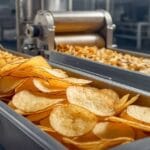The production of fermented dairy products has advanced significantly, evolving from a chance discovery to a sophisticated process. Exopolysaccharides (EPS) increase the time that milk product spends in the mouth and hence impart an enhanced perception of taste through improved volatilization of the intrinsic flavours, explain Harpreet K. Khurana and S.K. Kanawjia.
Table of Contents
The production of fermented dairy and milk products has advanced significantly, evolving from a chance discovery to a sophisticated process. Central to this development is the use of specialized starter cultures of bacteria, which consistently produce the necessary acids to enhance the texture, flavor, and safety of these products. Alongside this, the food industry increasingly utilizes exopolysaccharides (EPS) produced by lactic acid bacteria as natural thickeners and stabilizers.
These EPS offer a healthier, additive-free alternative that meets consumer demand for low-fat, low-sugar dairy products, contributing to improved texture and stability. This exploration highlights the classification, production, and applications of EPS in fermented milk products, showcasing their significant impact on the food industry. For a closer look at how microbes and EPS have transformed fermented dairy products, read more here.
Evolution of Fermented Dairy Production
The role of microbes in producing fermented dairy and milk products has evolved from a chance discovery to a highly elaborated process involving the production of specialized “starter” cultures of bacteria that function consistently in large cultures. The growth of fermented dairy products has been instrumental in improving both the nutritional value and shelf life of milk-based offerings, as explored here.
Functions of Starter Cultures
The primary function of almost all starter cultures is to develop acid in the product. The secondary effects of acid production include coagulation, the expulsion of moisture, texture formation, and initiation of flavor production. Starters also help in imparting a pleasant acid taste, conferring protection against potential pathogens, and providing a longer shelf life to the product. Advances in starter cultures have paved the way for innovative solutions in dairy production, offering benefits in terms of safety and efficiency, as discussed here.
Introduction to Exopolysaccharides (EPS)
The food industry uses polysaccharides as thickeners, emulsifiers, gelling agents, and stabilizers. The demand for these ingredients is mostly met by alginates, carrageenan, cellulose, pectins, starches, etc. There is a growing interest in all-natural, healthy food products. Moreover, in various countries, the amount of stabilizers being used is regulated. In this respect, lactic acid bacteria (LAB) have great potential, as many of their representatives are known to produce exopolysaccharides (EPS). Learn more about how plant-based and natural alternatives are shaping the food industry here.
EPS from LAB is an alternative class of biothickeners, having potential for development and exploitation as functional food ingredients with both health and economic benefits. Consumer demand for milk products with low fat or sugar content and low levels of additives, as well as cost factors, make EPS a promising and viable alternative as these contribute to texture, mouth-feel, taste perception, and stability of the final product. This is especially relevant in markets focusing on dairy innovations, as highlighted here.
Health and Economic Benefits of EPS
EPS from LAB offer significant health and economic benefits, contributing to the texture, mouth-feel, taste perception, and stability of dairy products. These natural biothickeners provide an alternative to traditional stabilizers, aligning with consumer demand for healthier, low-fat, and low-sugar food options. For insights into consumer trends in low-fat and natural foods, check this resource.
Classification of Exopolysaccharides from Lactic Acid Bacteria
The name exopolysaccharides (EPS) as proposed by Sutherland (1972) provides a general term for various forms of bacterial polysaccharides found outside the cell wall. These extracellular, long-chain, high-molecular-mass polymers dissolve or disperse in water to give thickening or gelling properties and are indispensable tools in food product formulation. They consist of branched, repeating units of sugars or sugar derivatives.
These sugar units are mainly glucose, galactose, and rhamnose, in different ratios. They are secreted into their surroundings during growth and are not attached permanently to the surface of the microbial cell. This distinguishes them from the structurally similar capsular polysaccharides (CPS), which do remain permanently attached to the surface of the cell.
Homopolysaccharides: Types and Characteristics
EPS from LAB can be subdivided into two groups. The first group, homopolysaccharides, consists of four subgroups:
- a-D-glucans: These include dextrans (Leuconostoc mesenteroides subsp. mesenteroides and Leuc. mesenteroides subsp. dextranicum), mainly composed of a-1,6-linked glucose residues with variable (strain specific) degrees of branching at position 3, and less frequently at positions 2 and 4, and alternan (Leuc. mesenteroides) and mutans (Streptococcus mutans and Streptococcus sobrinus), both composed of a-1,3- and a-1,6-linkages.
- b-D-glucans: Composed of b-1,3-linked glucose molecules with b-1,2 branches, produced by Pediococcus spp. and Streptococcus spp.
- Fructans: Mainly composed of b-2,6-linked D-fructose molecules, such as levan produced by S. salivarius.
- Others: Like Polygalactans, composed of structurally identical repeating units with different glycosidic linkages.
Heteropolysaccharides: Importance in Fermented Milks
The second group, heteropolysaccharides, is produced by mesophilic (Lactococcus lactis subsp. lactis, L. lactis subsp. cremoris, Lactobacillus casei, Lb. sake, Lb. rhamnosus, etc.) and thermophilic (Lb. acidophilus, Lb. delbrueckii subsp. bulgaricus, Lb. helveticus, and S. thermophilus) LAB strains. This group of EPS is extremely important since they play an important role in the rheology, body/texture, and mouthfeel of fermented milks.
Applications of EPS in Fermented Dairy Products
A large variety of EPS can be produced by LAB employed for the production of fermented dairy products. In particular, for the production of yogurt, drinking yogurt, cheese, fermented cream, and milk-based desserts, EPS-producing LAB play a significant role. They play a major role in the production of fermented dairy products in Northern Europe, Eastern Europe, and Asia. For an in-depth look at regional dairy trends, explore here.
Role of EPS in Scandinavian Fermented Milk Drinks
EPS-producing lactic cultures have also been successfully used for the manufacture of Nordic ropy milks. Scandinavian fermented milk drinks display a firm thick, slimy consistency, relying on the souring capacity of mesophilic ropy strains of Lactococcus lactis subsp. lactis and ssp. cremoris and concomitant production of heterotype EPS for texture. Early studies on the isolates from commercially produced Swedish “Langfil” and Finnish “Viili” suggested the involvement of slime or capsular material in developing the typical viscoelastic properties of these products (Macura and Townsley, 1984). Early research on such products showcased their unique viscoelastic properties, with more details available here.
Technical Benefits of EPS in Yogurt Production
The success of the application of EPS is determined by its ability to bind water, interact with proteins, and increase the viscosity of the milk serum phase. EPS may act as texturizers and stabilizers and consequently avoid the use of food additives. Creamy, smooth texture is one of the aspects of yogurt quality, which seems to be improved by the ability of the yogurt bacteria to produce EPS.
In addition, EPS from LAB has one of the largest technical potentials for the development of novel and improved products such as low-milk-solid yogurts, low-fat yogurts, creamier yogurts, and other fermented milk products. Learn about how these improvements align with regulatory trends in food safety here.
Enhancing Quality in Stirred Fermented Milk Products
EPS-producing lactic cultures are also useful for stirred fermented milk products, as stirred products possess a smooth, creamy texture and are made by mild homogenization of the coagulum after fermentation. The presence of EPS in stirred-type fermented milks makes them less susceptible to mechanical damage from pumping, blending, and filling machines.
Mechanical processing steps also increase syneresis of the final product, but the use of EPS-producing LAB can help to control this defect. This aligns with broader trends in sustainable and high-quality dairy manufacturing, as described here.
Image courtesy: Image by freepik
‘Processed Food Industry’: The Voice of Food Processing Industry
Processed Food Industry (PFI) is a premier English-language monthly B2B publication (ISSN 09721649) headquartered in New Delhi, catering to the vibrant and ever-evolving food processing industry. While we don’t claim to be the largest or most widely read, our proud legacy of over 27 years—publishing continuously since 1997—has earned us the trust of industry professionals as a reliable source of insights and information.
If your goal is to tap into the booming Indian and South Asian markets to promote your equipment, technology, software, or consumables, PFI is your strategic partner. With our hybrid approach across print, web, and social media, we help you establish strong brand recognition rooted in market relevance. Backed by a team of top-tier technical writers, we’re ready to work closely with you and your customers to craft compelling content that drives results.
India and South Asia’s food industry is expanding rapidly, driven by efficiency and cutting-edge innovations. Don’t miss the opportunity to elevate your brand and engage with this dynamic market. Get our 2025 media kit to fine-tune your marketing strategy, increase your visibility, and convert potential customers into valuable conversations. Additionally, ask for a sample copy of our monthly magazine and experience the quality and relevance we deliver.
Let us help you define your role in the future of the food processing industry.

Have a news or topic to share with industry? Write to us [email protected]















